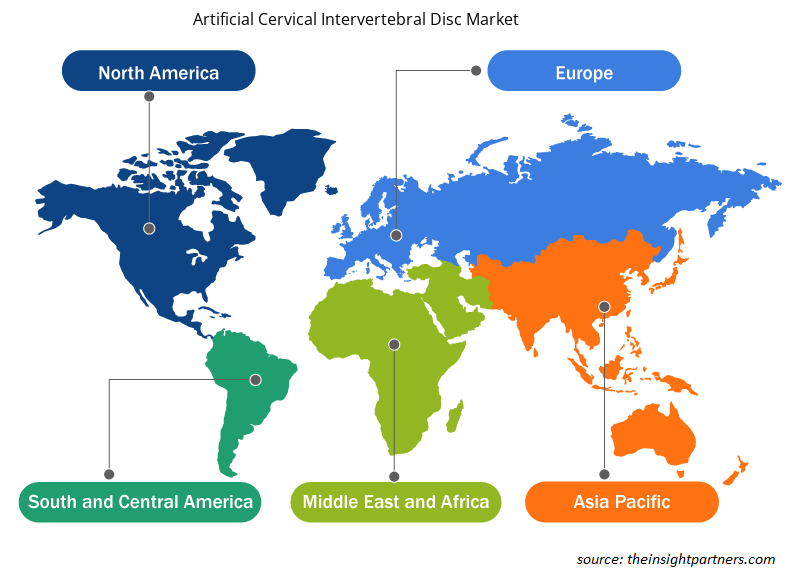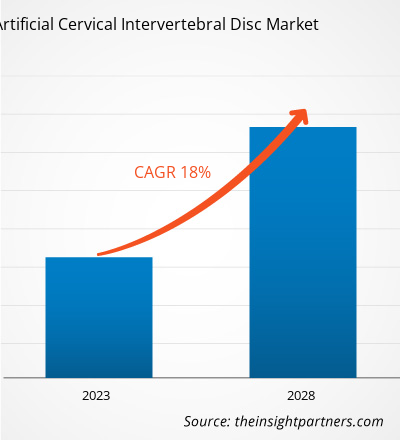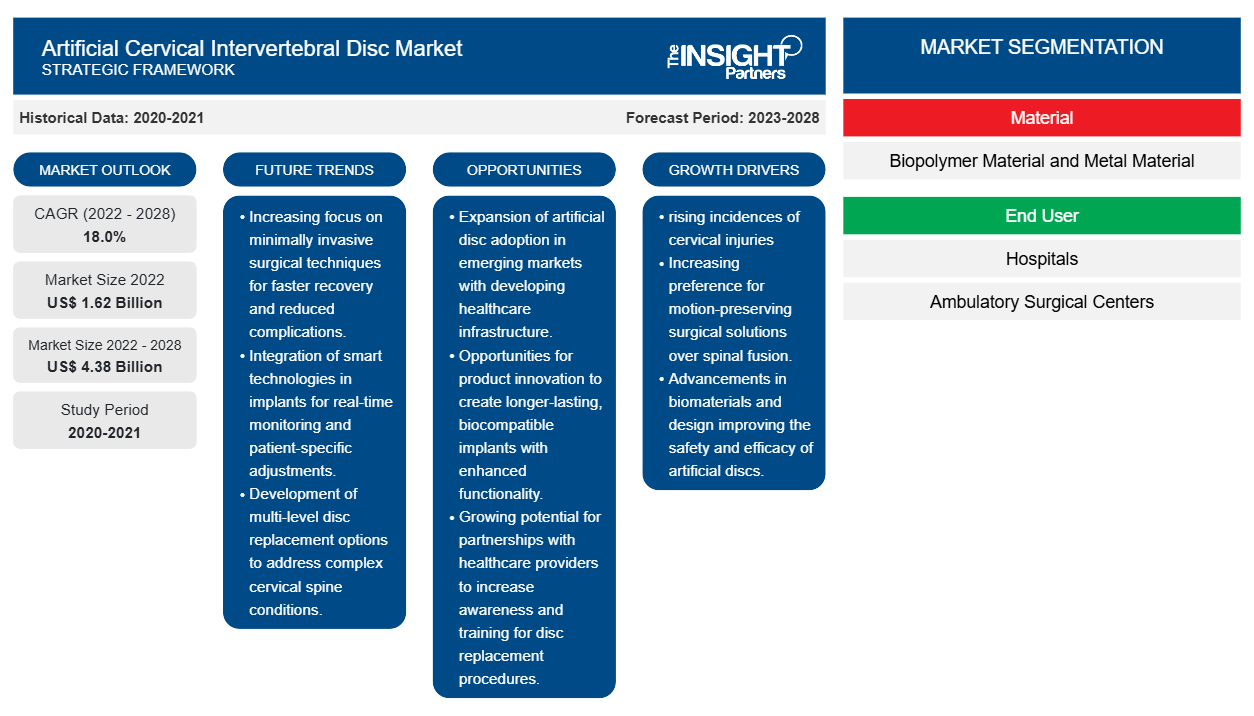[Rapport de recherche] La taille du marché des disques intervertébraux cervicaux artificiels devrait passer de 1 621,66 millions USD en 2022 à 4 375,29 millions USD d'ici 2028 ; elle devrait croître à un TCAC de 18,0 % de 2022 à 2028.
La croissance du marché des disques intervertébraux cervicaux artificiels est attribuée à la prévalence croissante des blessures cervicales. Les traumatismes sont le principal facteur de blessures cervicales, notamment les accidents de la route, les traumatismes pénétrants ou contondants, les chutes et les blessures liées au sport ou à la plongée. Selon l'étude « Estimating the Number of Traffic Crash-Related Cervical Spine Injuries in the US: an Analysis and Comparison of the National Crash and Hospital Data », publiée en 2020, aux États-Unis, environ 869 000 blessures de la colonne cervicale liées aux accidents de la route sont observées dans les hôpitaux chaque année, dont environ 841 000 sont des entorses/foulures (coup du lapin), 2 800 sont des lésions du disque vertébral, 23 500 sont des fractures, 2 800 sont des lésions de la moelle épinière et 1 500 luxations. En outre, la plupart des blessures sportives sont des blessures orthopédiques, notamment des foulures, des entorses, des fractures, des ligaments cassés, des douleurs et des gonflements ; celles-ci peuvent être aiguës ou chroniques. Selon Stanford Children's Health, environ 30 millions de jeunes et d'enfants aux États-Unis pratiquent un sport chaque année et plus de 3,5 millions de blessures liées au sport sont signalées chaque année. Une fracture cervicale résulte d'un traumatisme à haute énergie, comme une chute en gymnastique, au hockey, au football ou en plongée. L'incidence des fractures est élevée chez les athlètes. Selon le rapport Spinal Cord Injury Facts and Figures at a Glance, 2020, aux États-Unis, environ 7,8 % du total des lésions de la moelle épinière (LME) sont dues au sport. Selon la Commission américaine de sécurité des produits de consommation (CPSC), en 2018, environ 23 720 fractures du cou ont été traitées aux urgences des hôpitaux aux États-Unis ; parmi celles-ci, environ 3 194 étaient dues au sport. L'incidence des blessures sportives augmente avec la participation accrue aux sports et la participation active aux activités de remise en forme en raison de l'accent croissant mis sur une vie saine dans le monde entier. De plus, selon le National Spinal Cord Injury Statistical Center, la plongée est la cinquième cause de lésions graves de la moelle épinière cervicale. Par conséquent, la demande de disques intervertébraux cervicaux artificiels augmente en raison de l'incidence croissante des blessures cervicales.
Le disque intervertébral cervical a la capacité d'absorber une charge de compression énorme tout en offrant différents types de mouvement entre les os du cou. Les acteurs du marché ont développé plusieurs disques intervertébraux cervicaux artificiels qui sont utilisés pour traiter les problèmes de disques cervicaux. Le disque cervical artificiel remplace la fonction de mouvement et d'amortissement du disque cervical endommagé.
Personnalisez ce rapport en fonction de vos besoins
Vous bénéficierez d'une personnalisation gratuite de n'importe quel rapport, y compris de certaines parties de ce rapport, d'une analyse au niveau des pays, d'un pack de données Excel, ainsi que de superbes offres et réductions pour les start-ups et les universités.
-
Obtenez les principales tendances clés du marché de ce rapport.Cet échantillon GRATUIT comprendra une analyse de données, allant des tendances du marché aux estimations et prévisions.
Informations sur le marché
L'augmentation de la population gériatrique stimule le marché des disques intervertébraux cervicaux artificielsIntervertebral Cervical Discs Market
Le processus de vieillissement affecte la colonne cervicale, le cou, les épaules, le haut du dos et les bras. La spondylose cervicale est un terme désignant l'usure liée à l'âge des disques vertébraux du cou. Il s'agit d'une maladie courante qui s'aggrave avec l'âge. Selon l'Académie américaine des chirurgiens orthopédiques, environ 85 % des personnes de plus de 60 ans sont touchées par la spondylose cervicale. Avec l'âge, les disques vertébraux, qui servent d'amortisseurs, s'assèchent progressivement et affectent la force. Selon la fiche d'information : Le vieillissement aux États-Unis, le nombre de personnes âgées de 65 ans et plus devrait atteindre environ 95 millions d'ici 2060, contre 52 millions en 2018, et sa part dans la population totale devrait passer de 16 % à 23 %. En outre, selon le rapport « Later Life in the UK 2019 - Age UK », environ 12 millions (11 989 322) de personnes âgées de 65 ans et plus au Royaume-Uni, dont 5,4 millions de personnes âgées de 75 ans ou plus et 1,6 million de personnes âgées de 85 ans. En outre, le Japon est un autre pays vieillissant, avec 28,7 % de sa population âgée de 65 ans ou plus. La société « super âgée » du pays est la plus âgée du monde. Ainsi, le vieillissement croissant de la population est susceptible d'accroître la demande de disques intervertébraux cervicaux artificiels.
Informations basées sur les matériaux
En fonction du matériau, le marché des disques intervertébraux cervicaux artificiels a été divisé en matériaux biopolymères et matériaux métalliques. Le segment des matériaux biopolymères devrait détenir une part plus importante du marché en 2022, la croissance étant principalement attribuée à la biocompatibilité et à la facilité d'insertion offertes par les disques en matériaux biopolymères. Cependant, le segment des matériaux métalliques devrait enregistrer un TCAC plus élevé sur le marché au cours de la période 2022-2028.
Les acteurs du marché des disques intervertébraux cervicaux artificiels adoptent des stratégies organiques telles que le lancement et l'expansion de produits pour étendre leur empreinte et leur portefeuille de produits à l'échelle mondiale et répondre à la demande croissante. Les développements des entreprises sur le marché mondial des disques intervertébraux cervicaux artificiels ont été caractérisés comme des développements organiques et inorganiques. Les stratégies de croissance organique adoptées par les acteurs du marché comprennent le lancement et l'expansion de produits. Les stratégies de croissance inorganiques observées sur le marché des disques intervertébraux cervicaux artificiels étaient des partenariats et des collaborations. Ces stratégies de croissance ont permis aux acteurs du marché d'étendre leurs activités et d'améliorer leur présence géographique. De plus, les stratégies de croissance telles que les acquisitions et les partenariats ont contribué à renforcer la clientèle de l'entreprise et à augmenter son portefeuille de produits. Les développements organiques représentent 80,95 % du total des développements stratégiques sur le marché, tandis que les stratégies inorganiques représentent 19,05 % de la croissance des entreprises.
Le marché des disques intervertébraux cervicaux artificiels a été segmenté comme suit :
Le marché des disques intervertébraux cervicaux artificiels est segmenté en fonction du matériau et de l'utilisateur final. En fonction du matériau, le marché est divisé en biopolymère et en métal. Le marché mondial des disques intervertébraux cervicaux artificiels, en fonction de l'utilisateur final, est segmenté en hôpitaux, centres de chirurgie ambulatoire et autres.
Aperçu régional du marché des disques intervertébraux cervicaux artificiels
Les tendances et facteurs régionaux influençant le marché des disques intervertébraux cervicaux artificiels tout au long de la période de prévision ont été expliqués en détail par les analystes d’Insight Partners. Cette section traite également des segments et de la géographie du marché des disques intervertébraux cervicaux artificiels en Amérique du Nord, en Europe, en Asie-Pacifique, au Moyen-Orient et en Afrique, ainsi qu’en Amérique du Sud et en Amérique centrale.

- Obtenez les données régionales spécifiques au marché des disques intervertébraux cervicaux artificiels
Portée du rapport sur le marché des disques intervertébraux cervicaux artificiels
| Attribut de rapport | Détails |
|---|---|
| Taille du marché en 2022 | 1,62 milliard de dollars américains |
| Taille du marché d'ici 2028 | 4,38 milliards de dollars américains |
| Taux de croissance annuel composé mondial (2022-2028) | 18,0% |
| Données historiques | 2020-2021 |
| Période de prévision | 2023-2028 |
| Segments couverts |
Par matériau
|
| Régions et pays couverts |
Amérique du Nord
|
| Leaders du marché et profils d'entreprises clés |
|
Densité des acteurs du marché des disques intervertébraux cervicaux artificiels : comprendre son impact sur la dynamique commerciale
Le marché des disques intervertébraux cervicaux artificiels connaît une croissance rapide, tirée par la demande croissante des utilisateurs finaux en raison de facteurs tels que l'évolution des préférences des consommateurs, les avancées technologiques et une plus grande sensibilisation aux avantages du produit. À mesure que la demande augmente, les entreprises élargissent leurs offres, innovent pour répondre aux besoins des consommateurs et capitalisent sur les tendances émergentes, ce qui alimente davantage la croissance du marché.
La densité des acteurs du marché fait référence à la répartition des entreprises ou des sociétés opérant sur un marché ou un secteur particulier. Elle indique le nombre de concurrents (acteurs du marché) présents sur un marché donné par rapport à sa taille ou à sa valeur marchande totale.
Les principales entreprises opérant sur le marché des disques intervertébraux cervicaux artificiels sont :
- Zimmer Biomet Holdings, Inc.
- Globus Médical, Inc.
- Centinel Spine, LLC
- Solutions Synergy Spine, Inc.
- Aditus Médical
Avis de non-responsabilité : les sociétés répertoriées ci-dessus ne sont pas classées dans un ordre particulier.

- Obtenez un aperçu des principaux acteurs clés du marché des disques intervertébraux cervicaux artificiels
Profils d'entreprise
- Zimmer Biomet Holdings, Inc.
- Globus Médical, Inc.
- Centinel Spine, LLC
- Solutions Synergy Spine, Inc.
- B. Braun Melsugen AG
- Aditus Médical
- AxioMed SARL
- NuVasive, Inc.
- Medtronic
- Analyse historique (2 ans), année de base, prévision (7 ans) avec TCAC
- Analyse PEST et SWOT
- Taille du marché Valeur / Volume - Mondial, Régional, Pays
- Industrie et paysage concurrentiel
- Ensemble de données Excel
Rapports récents
Témoignages
Raison d'acheter
- Prise de décision éclairée
- Compréhension de la dynamique du marché
- Analyse concurrentielle
- Connaissances clients
- Prévisions de marché
- Atténuation des risques
- Planification stratégique
- Justification des investissements
- Identification des marchés émergents
- Amélioration des stratégies marketing
- Amélioration de l'efficacité opérationnelle
- Alignement sur les tendances réglementaires























 Obtenez un échantillon gratuit pour - Marché des disques intervertébraux cervicaux artificiels
Obtenez un échantillon gratuit pour - Marché des disques intervertébraux cervicaux artificiels